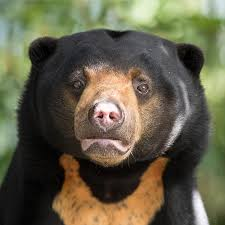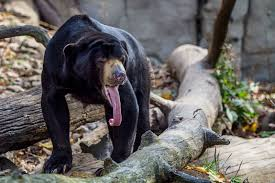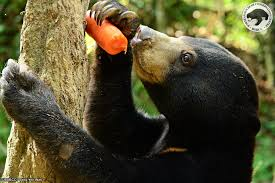This week we are looking at a species of bear I have never
heard of, that being the sun bear it is found in the tropical forests of
Southeast Asia. It is the only species in the genus Helarctos and they are the smallest
bear species and are only around half the size of an American black bear,
measuring 4-5 feet tall when stood on their hind limbs, and weighing up to
68kg.
Sun bears are named for the bib of often sunshine-yellow fur
adorning their chests. Each sun-bear bib is unique and can be used to
distinguish one bear from another. Their fur is thick, short and generally
jet-black, although some bears have a reddish or silvery hue.
Despite their name, recent research on wild sun bears
suggests these animals are crepuscular, meaning their activity levels peak
during the twilight hours of dawn and dusk.
They are known to be very aggressive and may attack without apparent provocation. Except for females with cubs the bears are solitary although there is a suggestion that same may form long-term monogamous relationships. Litters are of from 1 to 3 cubs with no apparent set period for mating or birth.
Relative to their skull size, sun bears have the largest
canine teeth of any bear species. For context, sun bear canines are the same
size as those sported by polar bears, and species some 5 to 10 times larger.
Sun bears have long, curved claws, are well adapted for
gripping bark and are the most arboreal of all the bear species. These bears
will climb trees to forage for wild fruits and beehives and to evade predators
such as tigers, leopards and dholes, an Asian canid. One of the characteristic
signs of the presence of wild sun bears is claw marks on trees they have
climbed.
They have exceptionally long tongues, the longest among
all bear species, reaching up to 25-30 centimetres (10-12 inches). These
long, sticky tongues are essential for their diet, allowing them to extract
insects and honey from hard-to-reach places like tree crevices and termite
mounds.
Sun bears primarily inhabit dense tropical and subtropical rainforests throughout Southeast Asia. Their range includes areas in northeastern India, Bangladesh, Myanmar, Thailand, Peninsular Malaysia, Laos, Cambodia, Vietnam, southern China, and the Indonesian islands of Sumatra and Borneo. They are typically found at lower altitudes in these forests but can be seen at higher elevations in some regions like India.
They are omnivorous, favouring fruits, insects, small
animals and bee nests (for insects and honey). Large teeth and long claws
enable sun bears to tear into logs and termite mounds in search of insects an
important component of their diet. Their tropical habitat generally provides
food resources year-round, so sun bears do not hibernate.
Sun bears face significant threats from habitat loss
due to deforestation and conversion of forests for agriculture, particularly
oil palm plantations. They are also targeted by commercial hunting for
their bile, paws, and other body parts, and are affected by the illegal pet
trade.








Cute except for the tongue but it serves a purpose. I never heard of the Sun bear either. Interesting. Thanks for the lesson.
ReplyDeleteThe long tongue seem weird to me but I guess that's the way it is
DeleteI too hadn't heard of Sun bear. It seems to have less hair on its body compared to the ones I have known. Sad that it's facing extinction.
ReplyDelete-- Pradeep / Time and Tide
Yes new to me also I hope they don't become extinct
DeleteHaven't heard of this bear, but so interesting, Jo-Anne.
ReplyDeleteYes it is interesting
DeleteI've seen a couple of these guys ... they seem so quiet and sweet, but it sounds like they can be just the opposite.
ReplyDeleteYou have seen them that is wonderful
DeleteI'm so surprised to find any bear living in a tropical climate, Jo-Anne. Very unique creatures!
ReplyDeleteYeah they are unique
DeleteI learned about these many years ago on a nature program. They are very handsome bears, but sound unpredictable.
ReplyDeleteThat's cool you have heard of them, I had not
DeleteI think we had one at our zoo at one point...
ReplyDeleteI think they only way I would see one would be in a zoo
Delete